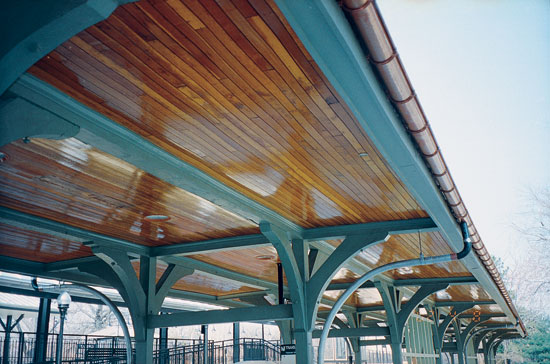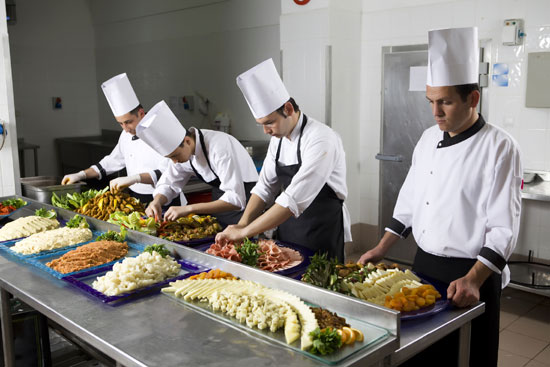High-Performance Coatings for Commercial Applications
Types of High-Performance Commercial Coatings
In a survey conducted by Emerging Trends in Real Estate®, real estate professionals predict a growing demand for commercial real estate across all property types in 2014. That's not just good news for realtors, it's good news for architects and designers whose job is to help their clients protect and beautify their new properties. The new breed of high-performance coatings gives you and your clients more options than ever when it comes to satisfying the demands of diverse applications.
Typically, high-performance commercial coatings fall into five categories, which include acrylics, epoxies, urethanes, alkyds, and hybrids. Each type is formulated to deliver dependable performance for different applications, so it's important to consider their distinct benefits.
Acrylic Coatings
The many advantages of acrylic coatings make them a popular choice for many commercial projects.
Not only do acrylics feature easy application and fast dry times, they have relatively little odor in comparison to solvent-based coatings. This is important in an industry where time is money, and staying on schedule can make or break a construction budget. Laser, R.A. in New York City, agrees, “In the past, I've specified alkyds for their durability, but my commercial clients want the job finished yesterday, so the long dry times required for multiple coats of alkyd paint is always a drawback. If a high-performance acrylic has the durability of an alkyd, with faster dry time, that's definitely an asset.”
Flexible paint film and lasting color and gloss retention also make high-performance acrylics suitable for exterior applications. Because acrylics are water based, they typically have lower VOC levels and have less environmental impact than solvent-borne alkyds. If there's a limitation to acrylics, they require a thoroughly clean substrate to achieve good adhesion, so they're not recommended for renovating workshops, storage areas, or manufacturing facilities where it's not cost-effective, or even possible, to clean the surface properly.
Acrylics may be further divided into three subsets:
Acrylic metal primers, which often have advanced formulas to inhibit the formation of rust on prepared steel, are compatible with water-based and solvent-based topcoats.

Photo courtesy of Sherwin-Williams
Acrylic topcoats are formulated for durable flexibility and offer good UV resistance to guard against yellowing over time, making them a great choice for exterior architectural metal siding or exposed metal.
Acrylic topcoats. With a smooth, attractive finish that rivals many premium architectural coatings, acrylic topcoats are popular for high-aesthetic areas such as hotel lobbies, restaurants, retail stores, office buildings, or community centers. Their low-odor formulations compared to solvent-based coatings and fast drying time cause minimal disruption to occupants, and facilities return to service fast. Because high-performance acrylics also have excellent gloss and color retention, they are well suited for exterior surfaces that are subject to UV exposure. Structural steel and piping are also common applications for acrylic topcoats. For projects that must meet the strictest environmental regulations, many high-quality acrylics are also available in low-VOC formulas.
Epoxy Coatings
Advanced-formula epoxies make up the second category of coatings suitable for busy commercial settings. With a hard, durable finish that provides excellent resistance to moisture, chemicals, abrasion, and corrosion, modern epoxy coatings are often the “go-to” solution for some of the most challenging high-demand commercial environments. Strong odor during application and some epoxies requiring mixing of two parts may be drawbacks in some situations, but should not rule out the many benefits of an epoxy coating.
To ensure the best possible choice for the job, there are several types of epoxies available.
Pre-catalyzed water-based epoxies are revolutionary acrylic epoxies that offer adhesion, durability, and chemical resistance comparable to traditional two-part epoxies in a fool-proof, single-component formula. For busy in-house maintenance crews, pre-catalyzed water-based epoxies offer significant convenience by eliminating the need for measuring, mixing, and applying a two-part formula with a limited pot life. Because they're water based, they are typically lower odor compared to solvent-based coatings and much lower in VOCs than solvent-based epoxies. With features similar to those of a traditional two-part water-based epoxy, these pre-catalyzed epoxies are equally suited to areas that get a lot of foot traffic or require frequent cleaning, such as hospital rooms, cafeterias, school classrooms, auditoriums, and dining halls.
Two-part water-based epoxies offer enhanced performance in facilities that require higher levels of defense from abrasion, chemicals, or moisture. Laboratories and clean rooms, operating rooms, public lavatories, school locker rooms, indoor pools, plus animal clinics and fitness centers are among the many areas where the constant use of water, cleaning chemicals, and scrubbing can require frequent repaints. In these situations, a high-performance water-based epoxy is formulated to retain its attractive, burnish-free finish far longer than standard architectural coatings.

Photo courtesy of Sherwin-Williams
For superior protection against harsh chemicals, moisture, and abrasion, water-based epoxies are an excellent choice. Patient rooms, school settings, and institutional kitchen walls are among recommended applications that must also meet strict environmental considerations.
High-performance water-based epoxies are also recommended for heavy-duty protection in high-traffic interiors. Schools, commercial hallways, airport terminals, and transit stations, as well as locker rooms, gymnasiums, laboratories, and light manufacturing facilities can benefit from the advantages of this very resilient coating.
Some water-based epoxies contain less than 50g/L VOC for the ultimate combination of high performance with low environmental impact. Sensitive interior environments, such as hospitals, operating rooms, or senior care centers, are among the recommended applications for a low-VOC water-based epoxy.
Solvent-based epoxy is the third type of epoxy. Highest in VOCs and typically requiring more labor than water-based epoxies, solvent-based epoxies are nevertheless hardworking, hard-wearing coatings that are ideal for sites that require maximum protection from harsh conditions. These extreme settings include commercial kitchens, chemical storage areas, fabrication shops, as well as chemical and water processing plants. Solvent-based epoxies are also tough enough for high-exposure exteriors, including offshore platforms, refineries, tanks, power plants, and structural steel. They can even withstand the demands of secondary containment applications and are acceptable for floors that are subject to light vehicle and forklift traffic.









